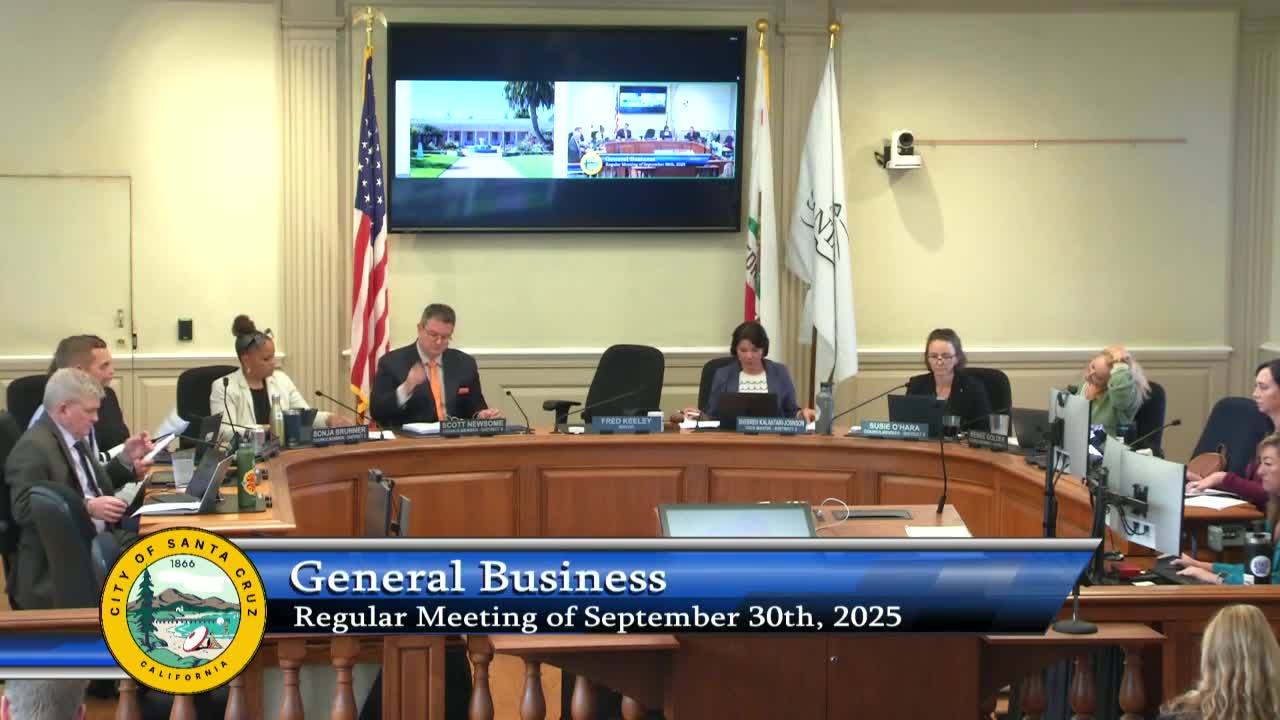Santa Cruz City Council Approves Anadromous Salmonid Habitat Conservation Plan Changes
October 04, 2025 | Santa Cruz County, California
This article was created by AI summarizing key points discussed. AI makes mistakes, so for full details and context, please refer to the video of the full meeting. Please report any errors so we can fix them. Report an error »

In the heart of Santa Cruz, city officials gathered under the warm glow of the council chamber lights to discuss a pivotal initiative that promises to reshape the community's relationship with its natural resources. The focus of the meeting was the Andromas Salmonelloid Habitat Conservation Plan Project, a significant step forward for the city’s water management and environmental stewardship.
Heidi Luckenbach, the city’s water director, took center stage, expressing her enthusiasm for the project and its implications not just for the water department, but for the entire community and ecosystem. “This is a big milestone,” she declared, emphasizing the collaborative effort that has spanned over two decades. Joined by dedicated staff members, Luckenbach aimed to simplify the complex details of the project, steering clear of technical jargon to ensure clarity for all attendees.
At the core of the discussion was the analogy of a three-legged stool, representing the interconnected components of the conservation plan, the Santa Cruz water rights project, and the overarching goal of ensuring water supply reliability. Each leg is essential; without one, the entire structure falters. The Andromas Salmonelloid Habitat Conservation Plan (ASHCP) is designed to guide the city in operating its water system while protecting local fish habitats, a critical aspect of maintaining ecological balance.
Luckenbach highlighted the historical context of Santa Cruz’s water system, which has relied on local sources since the late 1800s. The current system, primarily dependent on surface water, has faced challenges due to outdated water rights that inadequately address environmental needs. “There’s a disconnect that we had to address,” she noted, pointing out the necessity of modernizing these regulations to better align with contemporary environmental values.
The council's discussions echoed a broader commitment to sustainability and respect for the natural environment, values that have become increasingly important to the community. As the meeting progressed, it became clear that the Andromas Salmonelloid Habitat Conservation Plan is not merely a regulatory requirement; it represents a collective vision for a sustainable future where water management and ecological preservation go hand in hand.
As the council deliberated on the proposed actions, the atmosphere was charged with a sense of purpose. The decisions made in this meeting could set a precedent for how Santa Cruz navigates its environmental responsibilities in the years to come. With the community's support and a clear framework in place, the city is poised to take significant strides toward a more sustainable and resilient water system, ensuring that both residents and wildlife can thrive together.
Heidi Luckenbach, the city’s water director, took center stage, expressing her enthusiasm for the project and its implications not just for the water department, but for the entire community and ecosystem. “This is a big milestone,” she declared, emphasizing the collaborative effort that has spanned over two decades. Joined by dedicated staff members, Luckenbach aimed to simplify the complex details of the project, steering clear of technical jargon to ensure clarity for all attendees.
At the core of the discussion was the analogy of a three-legged stool, representing the interconnected components of the conservation plan, the Santa Cruz water rights project, and the overarching goal of ensuring water supply reliability. Each leg is essential; without one, the entire structure falters. The Andromas Salmonelloid Habitat Conservation Plan (ASHCP) is designed to guide the city in operating its water system while protecting local fish habitats, a critical aspect of maintaining ecological balance.
Luckenbach highlighted the historical context of Santa Cruz’s water system, which has relied on local sources since the late 1800s. The current system, primarily dependent on surface water, has faced challenges due to outdated water rights that inadequately address environmental needs. “There’s a disconnect that we had to address,” she noted, pointing out the necessity of modernizing these regulations to better align with contemporary environmental values.
The council's discussions echoed a broader commitment to sustainability and respect for the natural environment, values that have become increasingly important to the community. As the meeting progressed, it became clear that the Andromas Salmonelloid Habitat Conservation Plan is not merely a regulatory requirement; it represents a collective vision for a sustainable future where water management and ecological preservation go hand in hand.
As the council deliberated on the proposed actions, the atmosphere was charged with a sense of purpose. The decisions made in this meeting could set a precedent for how Santa Cruz navigates its environmental responsibilities in the years to come. With the community's support and a clear framework in place, the city is poised to take significant strides toward a more sustainable and resilient water system, ensuring that both residents and wildlife can thrive together.
View full meeting
This article is based on a recent meeting—watch the full video and explore the complete transcript for deeper insights into the discussion.
View full meeting
